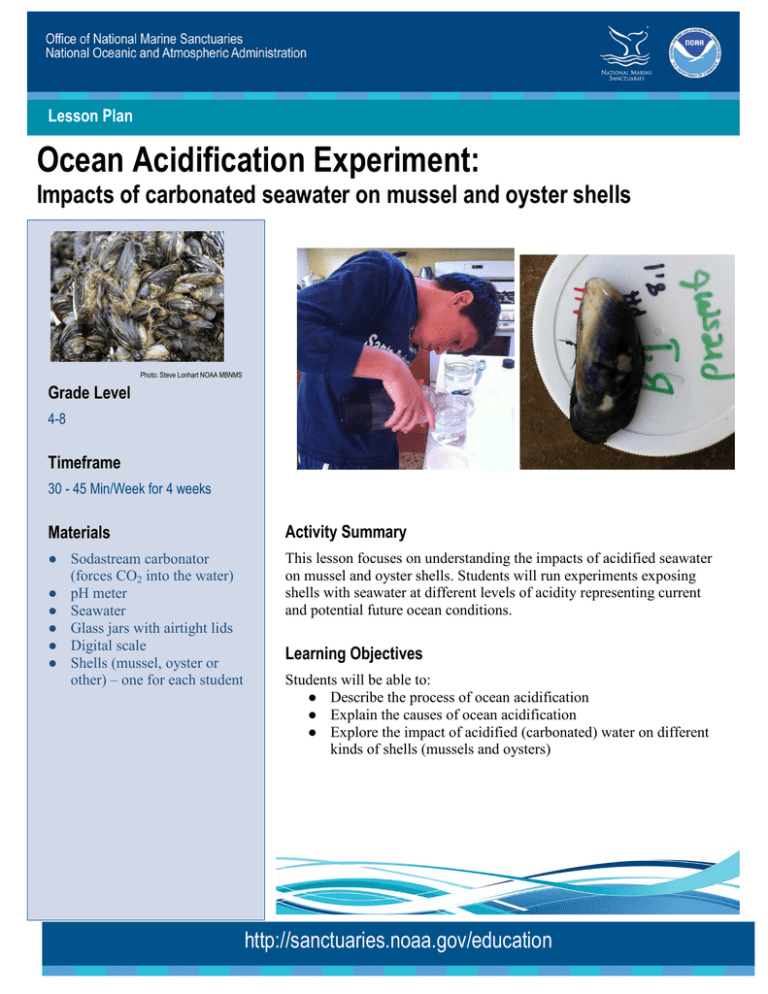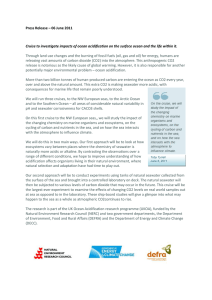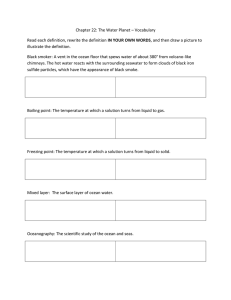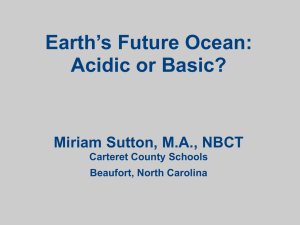See Lesson Plan
advertisement

Lesson Plan Ocean Acidification Experiment: Impacts of carbonated seawater on mussel and oyster shells Grade Level Photo: Steve Lonhart NOAA MBNMS 4-8 Timeframe 30 - 45 Min/Week for 4 weeks Materials Activity Summary ● Sodastream carbonator (forces CO2 into the water) ● pH meter ● Seawater ● Glass jars with airtight lids ● Digital scale ● Shells (mussel, oyster or other) – one for each student This lesson focuses on understanding the impacts of acidified seawater on mussel and oyster shells. Students will run experiments exposing shells with seawater at different levels of acidity representing current and potential future ocean conditions. Learning Objectives Students will be able to: ● Describe the process of ocean acidification ● Explain the causes of ocean acidification ● Explore the impact of acidified (carbonated) water on different kinds of shells (mussels and oysters) http://sanctuaries.noaa.gov/education David Fierstein (c) 2007 MBARI Background Information: The burning of fossil fuels for energy production, manufacturing, and transportation has driven the level of carbon dioxide in the atmosphere to levels 30% greater than prior to the industrial revolution. Higher atmospheric levels of carbon dioxide have resulted in increasing amounts of carbon dioxide dissolving in the ocean leading to the reduction in pH or increase in acidity of the ocean, also known as “ocean acidification”. It should be noted that the ocean is not acidic (pH<7) however the trend in declining pH has been observed and is referred to as “ocean acidification”. As shown in the chemical formulas in this illustration, when carbon dioxide (CO2) dissolves in seawater, it creates carbonic acid, which releases bicarbonate ions (HCO3-) and hydrogen (H+) ions into the water. The hydrogen ions make the seawater more acidic (lowering its pH). In addition, some of the hydrogen ions react with carbonate ions (CO3=) already in the seawater to create more bicarbonate. This reduces the amount of carbonate (an important mineral for building shells) dissolved in the seawater.The impacts of ocean acidification and lower carbonate ion concentrations on marine ecosystems include reduced growth of organisms that form calcareous skeletons or shells, such as corals, pteropods (swimming snails) and bivalves (such as oysters, clams and mussels). Since the beginning of the industrial revolution, about one third of the CO2 released by human activities has been absorbed by the world’s ocean which plays a key role in moderating climate change. Without the ocean absorbing CO2, the CO2 in the atmosphere would be much higher, potentially increasing the effects of global climate change. http://sanctuaries.noaa.gov/education Vocabulary Ocean Acidification - decrease in pH of the ocean caused by the uptake of atmospheric carbon dioxide Fossil Fuels – any combustible organic material derived from the remains of former life (i.e. oil, coal, or natural gas) pH - a logarithmic scale of hydrogen ion concentration Carbon Dioxide - a colorless, odorless gas present in the atmosphere. Anthropogenic – caused or produced by humans Learning Procedure: For this activity, students should understand that when humans release carbon dioxide into the atmosphere by burning fossil fuels, some of the carbon dioxide is absorbed by the ocean. This changes the chemistry of seawater making it more acidic. About one third of the carbon dioxide released into the atmosphere over the past 200 years has been taken up by the ocean. Ask students if they know what acids and bases are. Have students rank some common items along a spectrum of being more acidic to more basic (lemon juice, vinegar, soda, milk, ammonia). Ask students if they know where seawater fits in on the spectrum. Explain that pH is measured on a logarithmic scale like earthquakes and a small change in pH from 8.2 to 8.1 corresponds to an increase in acidity of about 30%. Values of 7.8 are expected by 2100, representing a doubling of acidity. Many shell forming organisms such a corals, bivalves (clams, mussels and oysters) and pteropods (free swimming snails) are sensitive to changes in pH. In this experiment, students will investigate the relationship between decreasing seawater pH on mussel and oyster shell mass. Have students develop a hypothesis about what they think will happen over the course of their experiment and have them record their hypothesis in their lab notebooks. Experimental Procedure: 1) Gather shells and dry overnight, make sure they are free of any tissue or biological debris. 2) Have students weigh each shell and record this mass as the initial mass at the beginning of the experiment. 3) Using a calibrated pH meter, measure pH of the seawater and have students record the number in their lab notebooks 4) Use the Sodastream to carbonate (acidify) one liter of sea water (3 pumps) 5) Measure pH of carbonated seawater using a calibrated pH meter and have students record that number in their notebooks 6) Pour regular (non-carbonated) seawater into glass jars (one for each student) with sealing lids. 7) Have students determine an approximate pH level where they would like to do their experiment. Make sure you reserve two shells to put in a jar with the regular noncarbonated seawater as your "control". Ask students why this is important. 8) Mix a small amount of acidic sea water (use an eyedropper and have students record the number of drops to get their desired pH). Keep the acidified sea water in a 1 liter bottle. Make sure to stir the seawater well and continue to add acidified sea water if needed. You can also put in a few drops of bromothymol blue (a pH indicator) to see a color change as you add the acidified water. http://sanctuaries.noaa.gov/education 9) Try to get a range of numbers from about pH 5 to pH 7.8. 10) You may want to have pairs of students work together so several students use the same water to run their experiments so you have replicates. Remember to fill the jars to the top (with a very small amount of space so you can put the shell in without overflowing) and measure pH before you seal them. 11) Have students label jars with their names and record the starting pH in their notebooks 12) Drop a shell into the seawater and seal lid. Ensure there is no air space at the top. 13) After one week have students measure pH and remove shells and dry them overnight. 14) If there has been a change of more than 0.1 pH unit, change out the water and fill jar with pH of the same value as the starting experiment. Have them look up the number of drops they used of the acidified water and repeat using that same number of drops. Record pH at start of second week in lab notebook. 15) After shells are dry, ask students to weigh shells and record mass. 16) Place shells back into jars with water at selected pH. Repeat data collection (weighing dry shells) every week for four weeks. Results ● Have students calculate the percent weight change over the duration of the experiment (ending weight-beginning weight)/beginning weight X 100. (Eg. (67)/7X100= -14% change from beginning weight.) ● Have the class make a line graph with pooled classroom data of with pH on the x axis and percent weight loss on the y axis. Analysis Describe your observations. Did your results support your hypothesis? Did the results surprise you? Why? How does this investigation demonstrate the effect of ocean acidification on shells? Conclusion: Reflect on the procedure and note any errors. If you saw a pH change in the seawater after one week, what could have been the cause? What results are important and what it could mean to the marine environment and animals with a calcium carbonate shell. Have students (individually or as a class) develop a solution to the problem of increasing ocean acidification. Have them compare different ideas and evaluate the effectiveness of differing solutions. Evaluation: Produce a presentation (oral, graphic/technological) representing the results of the experiment. Include theories as to why these results are important and what it could mean to the marine environment and animals with a calcium carbonate shell. Have students (individually or as a class) develop a solution to the problem of increasing ocean acidity. Have them compare different ideas and evaluate the effectiveness of differing solutions. Extensions: Have students read Earth’s Acid Test published in Nature March 10, 2011 and answer questions about the text. Have students participate in the International Student Carbon Footprint Challenge (http://footprint.stanford.edu/calculate.html). Students will investigate how to calculate their own carbon footprint and develop and present ideas on how they individually, as a family, and as a school community can lower their carbon footprint and help decrease the amount of CO2 (produced by the burning of fossil fuels) being absorbed by the world’s oceans. Have students present and compare their solutions to reduction of carbon footprint and have them use individual plans to come up with the best overall plan. For middle and high school students have students devise a way to evaluate the effectiveness of their solution(s). http://sanctuaries.noaa.gov/education Students will explore ways they can effect change in the use of fossil fuels beyond their home and school communities. Share portions of archived SOARCE (Sharing Ocean Acidification Resources for Communicators and Educators) Ocean Acidification webinars with students. http://oceanacidification.noaa.gov/AreasofFocus/ EducationOutreach/SOARCEWebinarSeries.aspx Additional Information: Where to get materials: ● Sodastream carbonator (http://www.amazon.com/SodaStreamFountain-Maker-StarterSilver/dp/B00EPEALEM/ref=sr_1_4?ie=UT F8&qid=1401128691&sr=84&keywords=soda+stream+carbonators) ● pH meter (http://www.amazon.com/HMDPHM80Digital-pH-TemperatureMeter/dp/B0096N8OWI/ref=pd_cp_hi_0) or http://www.equipcoservices.com/sales/ysi/ec osense_ph10.html ● Digital scale http://www.amazon.com/American-WeighDigital-PocketScale/dp/B003STEIYY/ref=sr_1_2?ie=UTF8 &qid=1379105964&sr=82&keywords=0.01g+scale) Acknowledgement This lesson is one in a series exploring ocean acidification. This lesson started out as a 6th grade science fair project by Jayden Francis and has been adapted for a broader audience. Correlation to Common Core and Next Generation Science Standards by Maria Petueli. This lesson was developed by the NOAA Channel Islands National Marine Sanctuary and is in the public domain, yet cannot be used for commercial purposes. Permission is hereby granted for the reproduction, without alteration, of this lesson on the condition its source is acknowledged. 6 Credit When reproducing this lesson, please cite NOAA National Marine Sanctuaries as the source and provide the following website: http://sanctuaries.noaa.gov/education. If you have any further questions or need additional information, email sanctuary.education@noaa.gov. Resources: http://www.cisanctuary.org/ocean-acidification/ http://oceanacidification.noaa.gov/ http://oceanacidification.noaa.gov/AreasofFocus/E ducationOutreach/SOARCEWebinarSeries.aspx This video recently came out after this lesson was developed but has a good video overview that could be used as an intro in the classroom. Southern Fried Science: Bad Gas: a step-by-step guide to experimenting with Ocean Acidification in your kitchen http://sanctuaries.noaa.gov/education Education Standards Common Core ELA Standards Informational Text Grades 4-8: 1 – Refer to details and examples in a text when explaining what the text says explicitly and when drawing inferences from the text 4 – Determine the meaning of general academic and domain-specific words or phrases in a text 7 – Interpret information presented visually, orally, or quantitatively and explain how the information contributes to an understanding of the text in which it appears. Writing Standards Grades 4-8: 1 – Write opinion pieces on topics or texts, supporting a point of view with reasons and information 2 – Write informative/explanatory texts to examine a topic and convey ideas and information clearly Common Core Math Standards Next Generation Science Standards 4 – Produce clear and coherent writing in which the development and organization are appropriate to task, purpose, and audience. Mathematical Practices: Construct viable argument and critique the reasoning of others Attend to precision Measurement and Data Grades 4-5 Represent and interpret data 4 Structure, Function, and Information Processing 4-LS1-1 Construct an argument that plants and animals have internal and external structures that function to support survival, growth, behavior, and reproduction Science and Engineering Practices: Engaging in Argument from Evidence Crosscutting Concepts: Cause and Effect Systems and System Models 3-5 Engineering Design 3-5ETS1-2 Generate and compare multiple possible solutions to a problem based on how well each is likely to meet the criteria and constraints of the problem. Science and Engineering Practices Constructing Explanations and Designing Solutions Crosscutting Concepts: Influence of Science, Engineering, and Technology on Society and the Natural World MS Human Impacts MS-ESS3-3 Apply scientific principles to design a method for monitoring and minimizing a human impact on the environment Science and Engineering Practices: Constructing Explanations and Designing Solutions Crosscutting Concepts: Cause and Effect Influence of Science, Engineering, and Technology on Society and the Natural World Ocean Literacy Principles 5 The ocean supports a great diversity of life and ecosystems 6 The ocean and humans are inextricably interconnected Climate Literacy Principles 3 Life on Earth depends on, is shaped by, and affects climate A,C,E 6 Human activities are impacting the climate system C,D,E http://sanctuaries.noaa.gov/education





